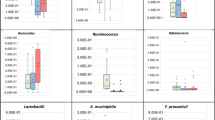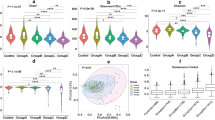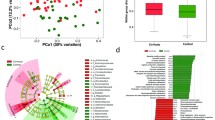Abstract
To unravel the profile of intestinal microecological parameters in Chinese patients with asymptomatic carriage of hepatitis B virus (HBV), chronic hepatitis B, decompensated HBV cirrhosis, and health controls and to establish their correlation with liver disease progression, we performed quantitative PCR and immunological techniques to investigate fecal parameters, including population of fecal predominant bacteria and the abundance of some virulence genes derived from Escherichia coli, Bacteroides fragilis, Clostridium difficile, and Clostridium perfringens in fecal crude DNA and some immunological parameters in extracts of all fecal samples. Data analysis indicated that 16S rRNA gene copy numbers for Faecalibacterium prausnitzii, Enterococcus faecalis, Enterobacteriaceae, bifidobacteria, and lactic acid bacteria (Lactobacillus, Pediococcus, Leuconostoc, and Weissella) showed marked variation in the intestine of HBV cirrhotic patients. The Bifidobacteria/Enterobacteriaceae (B/E) ratio, which may indicate microbial colonization resistance of the bowel, was decreased significantly in turn from 1.15 ± 0.11 in healthy controls, 0.99 ± 0.09 in asymptomatic carriers, and 0.76 ± 0.08 in patients with chronic hepatitis B to 0.64 ± 0.09 in patients with decompensated HBV cirrhosis (for all, P < 0.01). This suggests that B/E ratio is useful for following the level of intestinal microecological disorder in the course of liver disease progression. The data for virulence gene abundance suggested increased diversity of virulence factors during liver disease progression. Fecal secretory IgA and tumor necrosis factor-α in decompensated HBV cirrhotic patients were present at higher levels than in other groups, which indicates that a complicated autoregulatory system tries to achieve a new intestinal microecological balance.

Similar content being viewed by others
References
Barbut F, Gariazzo B, Bonne L, Lalande V, Burghoffer B, Luiuz R, Petit JC (2007) Clinical features of Clostridium difficile-associated infections and molecular characterization of strains: results of a retrospective study, 2000–2004. Infect Control Hosp Epidemiol 28:131–139
Bartosch S, Fite A, Macfarlane GT, McMurdo ME (2004) Characterization of bacterial communities in feces from healthy elderly volunteers and hospitalized elderly patients by using real-time PCR and effects of antibiotic treatment on the fecal microbiota. Appl Environ Microbiol 70:3575–3581
Bartosch S, Woodmansey EJ, Paterson JC, McMurdo ME, Macfarlane GT (2005) Microbiological effects of consuming a synbiotic containing Bifidobacterium bifidum, Bifidobacterium lactis, and oligofructose in elderly persons, determined by real-time polymerase chain reaction and counting of viable bacteria. Clin Infect Dis 40:28–37
Beckebaum S, Malago M, Dirsch O, Cicinnati VR, Trippler M, Lampertico P, Lama N, Treichel U, Gerken G, Broelsch CE (2003) Efficacy of combined lamivudine and adefovir dipivoxil treatment for severe HBV graft reinfection after living donor liver transplantation. Clin Transplant 17:554–559
Begley M, Gahana CGM, Hill C (2005) The interaction between bacteria and bile. FEMS Microbiol Rev 29:625–651
Blum S, Schiffrin EJ (2003) Intestinal microflora and homeostasis of the mucosal immune response: implications for probiotic bacteria? Curr Issues Intest Microbiol 4:53–60
Boullier S, Tanguy M, Kadaoui KA, Caubet C, Sansonetti P, Corthesy B, Phalipon A (2009) Secretory IgA-mediated neutralization of Shigella flexneri prevents intestinal tissue destruction by down-regulating inflammatory circuits. J Immunol 183:5879–5885
Brenchley JM, Price DA, Schacker TW, Asher TE, Silvestri G, Rao S, Kazzaz Z, Bornstein E, Lambotte O, Altmann D, Blazar BR, Rodriguez B, Teixeira-Johnson L, Landay A, Martin JN, Hecht FM, Picker LJ, Lederman MM, Deeks SG, Douek DC (2006) Microbial translocation is a cause of systemic immune activation in chronic HIV infection. Nat Med 12:1365–1371
Castelnau C, Le Gal F, Ripault MP, Gordien E, Martinot-Peignoux M, Boyer N, Pham BN, Maylin S, Bedossa P, Deny P, Marcellin P, Gault E (2006) Efficacy of peginterferon alpha-2b in chronic hepatitis delta: relevance of quantitative RT-PCR for follow-up. Hepatology (Baltimore, Md) 44:728–735
Chesta J, Silva M, Thompson L, del Canto E, Defilippi C (1991) Bacterial overgrowth in small intestine in patients with liver cirrhosis. Rev Méd Chile 119:626–632
Collins MD, Lawson PA, Willems A, Cordoba JJ, Fernandez-Garayzabal J, Garcia P, Cai J, Hippe H, Farrow JA (1994) The phylogeny of the genus Clostridium: proposal of five new genera and eleven new species combinations. Int J Syst Bacteriol 44:812–826
Cummings JH, Antoine JM, Azpiroz F, Bourdet-Sicard R, Brandtzaeg P, Calder PC, Gibson GR, Guarner F, Isolauri E, Pannemans D, Shortt C, Tuijtelaars S, Watzl B (2004) PASSCLAIM—gut health and immunity. Eur J Nutr 43(Suppl 2):II118–II173
Delacroix DL, Reynaert M, Pauwels S, Geubel AP, Vaerman JP (1982) High serum levels of secretory IgA in liver disease: possible liver origin of the circulating secretory component. Dig Dis Sci 27:333–340
Floch MH, Katz J, Conn HO (1970) Qualitative and quantitative relationships of the fecal flora in cirrhotic patients with portal systemic encephalopathy and following portacaval anastomosis. Gastroenterology 59:70–75
Fukushima H, Tsunomori Y, Seki R (2003) Duplex real-time SYBR green PCR assays for detection of 17 species of food- or waterborne pathogens in stools. J Clin Microbiol 41:5134–5146
Guarner F, Malagelada JR (2003) Gut flora in health and disease. Lancet 361:512–519
Haarman M, Knol J (2006) Quantitative real-time PCR analysis of fecal Lactobacillus species in infants receiving a prebiotic infant formula. Appl Environ Microbiol 72:2359–2365
Han DW (2002) Intestinal endotoxemia as a pathogenetic mechanism in liver failure. World J Gastroenterol 8:961–965
Hilali F, Ruimy R, Saulnier P, Barnabe C, Lebouguenec C, Tibayrenc M, Andremont A (2000) Prevalence of virulence genes and clonality in Escherichia coli strains that cause bacteremia in cancer patients. Infect Immun 68:3983–3989
Hodgson HJ (1985) Gut–liver interactions in the IgA system. Scand J Gastroenterol Suppl 114:39–44
Joishy M, Davies I, Ahmed M, Wassel J, Davies K, Sayers A, Jenkins H (2009) Fecal calprotectin and lactoferrin as noninvasive markers of pediatric inflammatory bowel disease. J Pediatr Gastroenterol Nutr 48:48–54
Jones J, Loftus EV Jr, Panaccione R, Chen LS, Peterson S, McConnell J, Baudhuin L, Hanson K, Feagan BG, Harmsen SW, Zinsmeister AR, Helou E, Sandborn WJ (2008) Relationships between disease activity and serum and fecal biomarkers in patients with Crohn’s disease. Clin Gastroenterol Hepatol 6:1218–1224
Kapel N, Roman C, Caldari D, Sieprath F, Canioni D, Khalfoun Y, Goulet O, Ruemmele FM (2005) Fecal tumor necrosis factor-alpha and calprotectin as differential diagnostic markers for severe diarrhea of small infants. J Pediatr Gastroenterol Nutr 41:396–400
Lamb CA, Mohiuddin MK, Gicquel J, Neely D, Bergin FG, Hanson JM, Mansfield JC (2009) Faecal calprotectin or lactoferrin can identify postoperative recurrence in Crohn’s disease. Br J Surg 96:663–674
Ma TY, Iwamoto GK, Hoa NT, Akotia V, Pedram A, Boivin MA, Said HM (2004) TNF-alpha-induced increase in intestinal epithelial tight junction permeability requires NF-kappa B activation. Am J Physiol 286:G367–G376
Macpherson AJ, Uhr T (2004) Induction of protective IgA by intestinal dendritic cells carrying commensal bacteria. Science (New York, NY) 303:1662–1665
Mariat D, Firmesse O, Levenez F, Guimaraes V, Sokol H, Dore J, Corthier G, Furet JP (2009) The Firmicutes/Bacteroidetes ratio of the human microbiota changes with age. BMC Microbiol 9:123
Martini GA, Phear EA, Ruebner B, Sherlock S (1957) The bacterial content of the small intestine in normal and cirrhotic subjects: relation to methionine toxicity. Clin Sci (Lond) 16:35–51
Miettinen TA (1972) Lipid absorption, bile acids, and cholesterol metabolism in patients with chronic liver disease. Gut 13:682–689
Moriya K, Sumi N, Nakao M, Yamazaki M, Saito M, Ito K (2000) The prevalence of virulence-related genes, eaeA, aggR and astA, of localized and aggregative-adherent Escherichia coli (EPEC and EAggEC) in healthy children and age-matched patients with diarrhea. Kansenshogaku Zasshi 74:134–142
Murray WR, Blackwood A, Calman KC, MacKay C (1980) Faecal bile acids and clostridia in patients with breast cancer. Br J Cancer 42:856–860
O’Sullivan DJ (2008) Genomics can advance the potential for probiotic cultures to improve liver and overall health. Curr Pharm Des 14:1376–1381
Palma P, Mihaljevic N, Hasenberg T, Keese M, Koeppel TA (2007) Intestinal barrier dysfunction in developing liver cirrhosis: an in vivo analysis of bacterial translocation. Hepatol Res 37:6–12
Pelletier G, Briantais MJ, Buffet C, Pillot J, Etienne JP (1982) Serum and intestinal secretory IgA in alcoholic cirrhosis of the liver. Gut 23:475–480
Ramachandran A, Balasubramanian KA (2001) Intestinal dysfunction in liver cirrhosis: its role in spontaneous bacterial peritonitis. J Gastroenterol Hepatol 16:607–612
Scholtens PA, Alliet P, Raes M, Alles MS, Kroes H, Boehm G, Knippels LM, Knol J, Vandenplas Y (2008) Fecal secretory immunoglobulin A is increased in healthy infants who receive a formula with short-chain galacto-oligosaccharides and long-chain fructo-oligosaccharides. J Nutr 138:1141–1147
Sharma N, Chaudhry R (2006) Rapid detection of enterotoxigenic Bacteroides fragilis in diarrhoeal faecal samples. Indian J Med Res 124:575–582
Si JM, Yu YC, Fan YJ, Chen SJ (2004) Intestinal microecology and quality of life in irritable bowel syndrome patients. World J Gastroenterol 10:1802–1805
Sokol H, Pigneur B, Watterlot L, Lakhdari O, Bermudez-Humaran LG, Gratadoux JJ, Blugeon S, Bridonneau C, Furet JP, Corthier G, Grangette C, Vasquez N, Pochart P, Trugnan G, Thomas G, Blottiere HM, Dore J, Marteau P, Seksik P, Langella P (2008) Faecalibacterium prausnitzii is an anti-inflammatory commensal bacterium identified by gut microbiota analysis of Crohn disease patients. Proc Natl Acad Sci USA 105:16731–16736
Song Y, Liu C, Finegold SM (2004) Real-time PCR quantitation of clostridia in feces of autistic children. Appl Environ Microbiol 70:6459–6465
Suzuki K, Meek B, Doi Y, Muramatsu M, Chiba T, Honjo T, Fagarasan S (2004) Aberrant expansion of segmented filamentous bacteria in IgA-deficient gut. Proc Natl Acad Sci U S A 101(7):1981–1986
Suzuki MT, Taylor LT, DeLong EF (2000) Quantitative analysis of small-subunit rRNA genes in mixed microbial populations via 5′-nuclease assays. Appl Environ Microbiol 66:4605–4614
Toprak NU, Yagci A, Gulluoglu BM, Akin ML, Demirkalem P, Celenk T, Soyletir G (2006) A possible role of Bacteroides fragilis enterotoxin in the aetiology of colorectal cancer. Clin Microbiol Infect 12:782–786
Usein CR, Damian M, Tatu-Chitoiu D, Capusa C, Fagaras R, Tudorache D, Nica M, Le Bouguenec C (2001) Prevalence of virulence genes in Escherichia coli strains isolated from Romanian adult urinary tract infection cases. J Cell Mol Med 5:303–310
van der Waaij D (1992) History of recognition and measurement of colonization resistance of the digestive tract as an introduction to selective gastrointestinal decontamination. Epidemiol Infect 109:315–326
Williams R (2007) Review article: bacterial flora and pathogenesis in hepatic encephalopathy. Aliment Pharmacol Ther 25(Suppl 1):17–22
Yan F, Polk DB (2004) Commensal bacteria in the gut: learning who our friends are. Curr Opin Gastroenterol 20:565–571
Yu H, Cao ZC, Geng JY, He ZG, Wang ZM, Sun XY, Wang ZH (2005) Effect of interferon alpha on liver fibrosis in patients with chronic hepatitis B. Di 1 Jun Yi Da Xue Xue Bao (Acad J First Med College PLA) 25:1409–1412
Zeuzem S (2000) Gut-liver axis. Int J Colorectal Dis 15:59–82
Zhang W, Zhao M, Ruesch L, Omot A, Francis D (2007) Prevalence of virulence genes in Escherichia coli strains recently isolated from young pigs with diarrhea in the US. Vet Microbiol 123:145–152
Acknowledgments
We gratefully acknowledge the physicians at the Department of Infectious Diseases and the surgeons at the Department of Surgery in the First Affiliated Hospital, College of Medicine, Zhejiang University, for their collaboration and collection of stool specimens. This study was supported by the National Basic Research Program (973) of China (2007CB513003), the Zhejiang Provincial Natural Science Foundation of China (Y20090363), and the Zhejiang Provincial Medical Scientific Research Foundation of China (Y200921311).
Author information
Authors and Affiliations
Corresponding author
Rights and permissions
About this article
Cite this article
Lu, H., Wu, Z., Xu, W. et al. Intestinal Microbiota Was Assessed in Cirrhotic Patients with Hepatitis B Virus Infection. Microb Ecol 61, 693–703 (2011). https://doi.org/10.1007/s00248-010-9801-8
Received:
Accepted:
Published:
Issue Date:
DOI: https://doi.org/10.1007/s00248-010-9801-8




